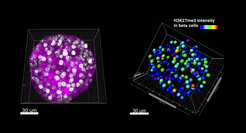Mind the marks
Epigenetic research reveals two subtypes of insulin-producing beta cells in the pancreas
Researchers from the Van Andel Institute and the Max Planck Institute of Immunobiology & Epigenetics, led by J. Andrew Pospisilik, have identified two distinct subtypes of pancreatic beta cells, each possessing distinctive characteristics in epigenomic marks, size, shape, and function. The findings give a more nuanced picture of beta cell biology and may allow new steps in diabetes research.

in beta cells.
When blood sugar levels rise, beta cells of the pancreas produce the hormone insulin to keep sugar levels in balance. However, when the number of beta cells is too low, or they aren’t functioning correctly, there isn’t enough insulin getting released, and this ultimatly results with diabetes, a set of diseases that affect hounderes of millions worldwide. New research by a team at the Van Andel Institute (USA) and the Max Planck Institute of Immunobiology and Epigenetics in Germany offer a more nuanced understanding of beta cell biology and could support diabetes therapy in the future.
It has been documented since the 1960s that beta cells can be different from one another. However, mechanisms that specify and stabilize bona fide beta cell subtypes remain poorly understood. The newest findings by the team in Freiburg and Michigan published in Cell Metabolism identified two unique and functionally distinct beta cell subtypes based on their epigenetic profile.
Different Chromatin organization, different subtypes
All cells in a multicellular organism share the same DNA sequence. Yet, the phenotype of each individual cell (sub-)type is unique and dictated by specific gene expression patterns. These patterns are facilitated through a set of epigenetic mechanisms that do not change the genetic information itself but affect what happens to the DNA at that particular location. “When we examined stained nuclei of beta cells, we noticed two different subtypes of cells separated by their chromatin structure,” says Erez Dror, first-author of the publication. In the nucleus, DNA is wrapped around histone proteins forming chromatin which can be modified by little chemical marks that impact the accessibility to DNA respective to the activation and silencing of genes.
Epigenetic dosage as a novel regulator of cell subtypes
The two subtypes of beta cells differ in the distribution of H3K27me3, a chemical mark that attaches to histone proteins and silences genes. “We have noticed that they divide into two epigenetically distinct subgroups, one high (βHI) and the other low (βLO) for this specific histone modification. And we expected that this unique feature is not just morphological as the chromatin structure ultimately affects the expression of genes in the cells,” says Erez Dror from the Max Planck Institute in Freiburg. However, it took the team overall six years and a lot of work to prove that the initial observation of two subgroups of epigenetically distinct cells are really stably distinct beta cell subtypes differing in epigenomic features, size, shape, and function.
Importantly, βHI cells secrete more insulin upon sugar stimulation and appear more prevalent in Type 2 diabetes, meaning there may be a subtype-specific response to the diseased state. The results can help develop more precise diabetes treatment strategies and pave the way for a better understanding of beta cell biology. “We still don’t know what affects the different chromatin structures of β cells. Therefore, it would be important to investigate how metabolic stress and inflammatory signaling, which are increased in diabetes, affect levels of the H3K27me3 marks and functions in these insulin-producing cells,” says Erez Dror.
ED/MR












